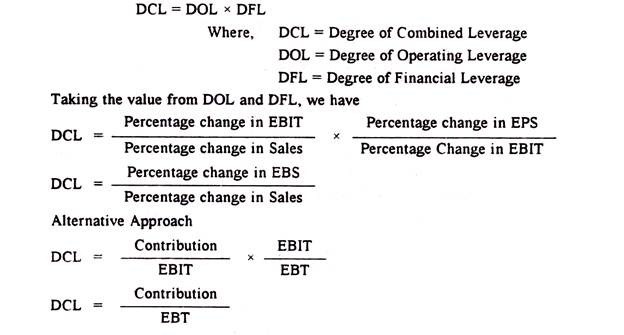The effect of debt- equity ratio on the earning and risk of shareholders can be known by studying financial leverage. If a firm is engaged in a business transaction, it can make use of debt and equity mix or can enjoy leverage benefits. For non-profit organization funds may be raised through only equity. For existing company’s growth and expansion may be financed through retained earnings, debenture or preference capital. Capital structure decision is one of the strategic decisions taken by the financial management. Considerable attention is required to decide the mix up of various sources of finance.

Equity shareholders tend to have more rights over a company in comparison to debenture and preference shareholders. The capital structure of the firm will be determined by the kind of shareholders and the limitations in their voting rights. It is defined as the proportion of debt that is an integral part of the total capital of the firm. A firm that has a high level of debt is considered to be a highly levered firm while the one with a low ratio of debt is a low levered firm. Debt capital in the capital structure of the company refers to the borrowed money at work. It is considered to be the cheaper form of financing capital as the interest payments on debts are tax-deductible expenses.
As a rule of thumb, the higher the proportion of debt financing a company has, the higher its exposure to risk will be. In most cases, a company that is financed primarily by debt will have a more aggressive capital structure, which means that investors who invest in the company are taking a greater risk. But it should be noted that this risk could well be the company’s primary source of growth.
Capital structure
By the above-mentioned definition, the company is said to be low-geared. Capital structure increases the country’s rate of investment and growth by increasing the firm’s opportunity to engage in future wealth-creating investments. Is a mediatory form of capital wherein they are shareholders of the entity with a preference over the common stockholders. A company with a higher debt-equity ratio is a highly leveraged company. Project FinancingProject Finance is long-term debt finance offered for large infrastructure projects depending upon their projected cash flows. Moreover, an investor has to form a Special Purpose Vehicle to acquire the same.
When debt is a portion of a firm’s capital structure, it permits the company to achieve greater earnings per share than would be possible by issuing equity. This is because the interest paid by the firm on the debt is tax-deductible. The reduction in taxes permits more of the company’s operating income to flow through to investors.
For instance, a cyclical business may not be able to afford to take on much debt, even if the interest rates pose a lower cost of capital than alternatives like equity financing. If it can’t afford to make the loan payments during the slow periods of its business cycle, the business must instead build a capital structure with other types of financing. In other words, the decisions of capital structure affect the value of the firm by the returns that are made available for the equity shareholders. On the other hand, leverage affect the value of the firm by the cost of capital. If funds are raised by the issue of equity shares, it requires dividends only if there is sufficient profits, whereas, in the latter case, it requires a fixed rate of interest irrespective of the profit or loss. Thus, the question of capital gearing arises as to on which fund a fixed rate of interest or dividend is paid.
This company is also an example of a low-risk equity capital structured company. Low geared companies – Those companies whose equity capital dominates total capitalization. A capital structure arbitrageur seeks to profit from differential pricing of various instruments issued by one corporation. The latter are bonds that are, under contracted-for conditions, convertible into shares of equity. The stock-option component of a convertible bond has a calculable value in itself.

An increase in financial leverage will lead to decline in the weighted average cost of capital , while the value of the firm as well as market price of ordinary share will increase. Shrewd companies will often try to achieve an optimal capital structure that maximizes the company’s market value while keeping the cost of capital to a minimum. Debt financing is usually cheaper than equity because of the tax deductions it affords.
Share By
Is the least known form of the capital structure wherein the suppliers will provide the goods on long-term credit to the entity. In liquidation of the entity, debt holders can prefer payment before the entity’s shareholders. Debt is the amount borrowed by the entity from the outsiders for business. The debt holders are liable to pay interest before paying taxes to the government.
- Again they may get a dividend lower than that on the preference shares when the company makes some profits.
- The articles and research support materials available on this site are educational and are not intended to be investment or tax advice.
- This is because the interest paid by the firm on the debt is tax-deductible.
- Decision with respect to financial structure or capital structure has an effect on the market value of the company’s shares.
- Alon with WACC, some of the other metrics can further be utilized for estimating the reasonableness of the capital structure of a company.
Remember, overall cost of capital is the outcome of capital structure. If a company plans to raise a smaller amount of capital, it selects only few securities in its capital structure. If it needs more capital, a number of different securities will be selected to raise funds in the capital structure. II. Raise 50 per cent as equity capital and 50 per cent as 10 per cent debt capital. Suppose a company raises $1,500,000 by issuing shares and $1,000,000 by issuing debentures.
This mix of debts and equities make up the finances used for a business’s operations and growth. For example, the capital structure of a company might be 40% long-term debt , 10% preferred stock, and 50% common stock. It alludes to the blend of capital, which comprises a mix of debt and equity. In summary, capital structure is the firm’s use of equity and debt financing to finance operations.
The screenshot below shows how two companies are combined and recapitalized to produce an entirely new balance sheet. Below is an illustration of the dynamics between debt and equity from the view of investors and the firm. In order to optimize the structure, a firm can issue either more debt or equity. The new capital that’s acquired may be used to invest in new assets or may be used to repurchase debt/equity that’s currently outstanding, as a form of recapitalization. Revenue so that the cost of capital can be met and the growth operations can be financed. A firm having a sound capital structure has a higher chance of increasing the market price of its shares and securities that it holds.
The Trade Off Theory
The investment and asset management decisions of the firm are held constant. With the same earning level, the financial manager will try to design the capital structure to raise the value of the firm. This Rs.10,00,000 fund is collected by issuing equity shares the tune of Rs.8,00,000, Rs.1,00,000 through 9% debentures and Rs.1,00,000 as term loan from banks.

Firm’s capital structure may be arrived at by use of equity share capital or preference share capital or debt capital or combination of all of them. The use of any one of these sources does not help come up with an optimum capital structure. Construction of optimum capital structure is possible only when there is an appropriate mix of the above sources .
The relative proportion of various sources of funds used in a business is termed as financial structure. Capital structure is a part of the financial structure and refers to the proportion of the various long-term sources of financing. It is concerned with making the array of the sources of the funds in a proper manner, which is in relative magnitude and proportion.
According to NOI approach, there is no relationship between the cost of capital and value of the firm i.e. the value of the firm is independent of the capital structure of the firm. The NOI approach is definitional or conceptual and lacks behavioral significance. capital structure definition However, Modigliani-Miller approach provides behavioural justification for constant overall cost of capital and therefore, total value of the firm. Conversely, if a business feels like its debt is getting out of hand, it might issue new stock.
Degree of control
Each of these three methods can be an effective way of recapitalizing the business.
For optimizing the structure, firms can give either more debt or equity. In a capital structure, equity financing comprises the common and preferred stock as well as retained earnings of a company. This is viewed as invested capital and it shows up in the equity section of the shareholder’s balance sheet. The traditional approach strikes a compromise between the first two theories. It proposes that there is an optimal capital structure where the WACC is at minimum and the value of the firm is at maximum.
This is because a business has several years or even decades in a few cases to clear its principal amount while paying just a percentage of interest until bond maturity. A majority of experienced corporate management is trying to find the perfect capital structure for risk/reward payoff. The third way is for unstable companies which have high debt liabilities. They prefer to https://1investing.in/ repay their debts with the help of the funds acquired through issuing of new shares. The weighted average cost of capital calculates a firm’s cost of capital, proportionately weighing each category of capital. Debt financing occurs when a firm raises money for working capital or capital expenditures by selling debt instruments to individuals and institutional investors.
Those companies whose equity capital dominates total capitalisation. According to Weston and Brigham, ‘Capital structure is the permanent financing of the firm represented by long-term debt, preferred stock and net worth’. Thus in its broader sense, Capital structure includes all the long term capital resources including loans, shares issued, reserves, etc. In the words of Weston and Brigham “Capital structure is the permanent financing of the firm, represented by long term debt, preferred stock, and net worth”. Financial structure shows how the permanent assets of a company are financed.
Run a Finance Blog? See How You Can Partner With Us
Capital structure, on the other hand, shows the kind of securities issued to raise the total amount. It is a qualitative concept representing the form of long-term financing. But the determination of such an optimum capital structure is a formidable task in practice.
